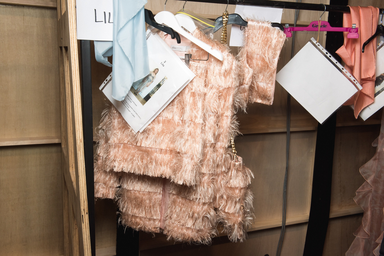Twice a year, international fashion houses congregate in the four major fashion capitals of the world— New York, London, Paris, and Milan— for a mythologized week of showcasing fashion collections for next season. On Monday, Feb. 3, the most brilliant minds in fashion will jet set from around the world to the Big Apple to see Fall 2020 collections modeled on the runway.
But is the glitz and the glam all that it’s cracked up to be? New York Fashion Week has influenced our style tastes for generations, but how has it fared in recent years? Let’s take a look at the origins of this historic event and its evolution over time.
- How Did New York Fashion Week Get Its Start?
-
New York Fashion Week was born in 1943 from the mind of infamous fashion publicist Eleanor Lambert during World War II. Up until that time, Parisian style was considered the pinnacle of fashion, as touted in publications like Vogue and Harper’s Bazaar. When U.S. journalists were barred from attending Paris Fashion Week during the German occupation of France in World War II, Lambert and her team hosted the first New York Fashion Week— originally titled “Press Week”. The first show featured household works from designers like Bill Blass, Oscar de la Renta, Mollie Parnis, Pauline Trigere and more.
Pivoting the focus from French style to stress the importance of American fashion, Lambert masterfully elevated American designers and American-made materials. With the success and persistence of Lambert’s show, magazines soon saw an uptick in coverage of American fashion. In 1962, Lambert cemented her legacy by founding the Council of Fashion Designers of America (CFDA) to organize and support fashion talent. The CFDA owns the Fashion Calendar and the New York Fashion Week schedule.
From there, the name changed to “Press Week of New York” in the mid-1950s. During the following decades, the weeklong event expanded to various, unique settings: galleries, loft spaces, nightclubs, restaurants, etc. However, in 1990, a Michael Kors show was interrupted when a piece of a loft ceiling fell upon a model and editors. Following this event, the industry decided to house all shows in Bryant Park— a location they called 7th on 6th. In 2001, 7th on 6th was then sold to IMG, which rebranded it to what we now call “New York Fashion Week.” Since then, the shows have moved around to the Lincoln Center and expanded to encompass various locations again.
- Who attends?
-
High fashion runways often conjure images of a frowning Anna Wintour sitting front row alongside prominent celebrities and many eyebrow-raising moments over the years. To a great extent, this unrelatable image does not prove untrue. Fashion week primarily consists of two different types of shows: industry and open-to-public. For those who do not work high up in the industry, hold press passes, or aren’t considered serious buyers, it’s nearly impossible to secure tickets to big name shows. However, public shows are open to any with an interest in fashion and the financial means to purchase a ticket.
The often exorbitant cost of attendance makes sense when analyzing the cost of the show itself. According to Vogue Business, hosting a New York Fashion Week show can cost anywhere from $125,000 to more than $300,000. It’s also difficult to find conclusive information on the costs and environmental impact of New York Fashion Week— likely due to the historical exclusivity and opaqueness of the shows’ carbon footprints.
- Has fashion week actually influenced society?
-
In the days of Lambert, the shift to American designers and materials saw a spike in the demand for American fashion. This rise of American fashion is arguably the most prominent effect of New York Fashion Week over time.
In addition, looks that were displayed on the runway proved to have a trickle-down effect to general retail stores— in a rather Devil Wears Prada manner. However, with collections being put together seasonally, some have argued that the message of clothing being limited to time-related relevancy has led to the massive spike of detrimental fast fashion.
In recent years, the changing landscape of fashion week attendees to include influencers with wide-reaching platforms granted the shows much-desired accessibility. With artistic and cultural changes happening in the industry and faced with much criticism surrounding climate change and diversity, New York Fashion Week is placed in an uncertain position and must decide what its legacy will be in coming years.
- What criticism has New York Fashion Week faced?
-
Critics of fashion week have much to say about the shows as well as the resource-pumping industry behind it all. One of the most media-prominent problems facing fashion week and the industry is the lack of diversity and inclusion on the runway. Historically, slim (and young) white women dominated the catwalks. Today, statistics have slowly begun to shift, with many lauding the Fall 2019 Fashion Week to be the most racially diverse yet. In fact, New York Fashion Week is often regarded as a trailblazer for diversity on the runway when compared to other fashion capitals.
According to W Magazine, “nearly one-third of shows in New York featured 50 percent or more models of color.” However, this statistic does not take into consideration transgender, nonbinary, plus-size, or older models who have also been historically underrepresented. Though some key players in the industry strive to increase diversity on their runways, many critics remain skeptical until long-term results can be measured.
Another major concern developed with the world’s rapidly changing climate. Fashion shows yield a massive carbon footprint between travel and production. In tandem, the rise of social media has also changed the landscape of fashion week with prominent coverage from influencers and their collective audiences. In an interview with Vogue, Thierry Dreyfus, the founder of production company Eyesight, discussed how Instagram “has changed not only the way we think about light design, but the way we think about the set and how people are seated…. You have to [bring users] inside this specific world.” Massive production costs to achieve such immersive spaces have had detrimental impacts on the environment with consumption of these resources.
- What can we expect from New York Fashion Week Fall 2020?
-
As the fashion world puts finishing touches on their collections for the upcoming shows, some surprising wrenches have been thrown into the mix. This season’s runway will be devoid of works from signature artists like Tommy Hilfiger, Ralph Lauren, Tom Ford, and more. In addition, the 2020 Oscars are slated to coincide with the middle of New York Fashion Week instead of directly following it. With celebrity stylists traditionally pulling outfits from the fashion week runway for their clients, the Oscars’ red carpet may lack influence from the new season’s collections. With many major names not showing collections at the show, critics are worried that this season’s New York Fashion Week may prove lackluster.
That all said, we’ll be keeping a close eye on the runways of New York this week!


